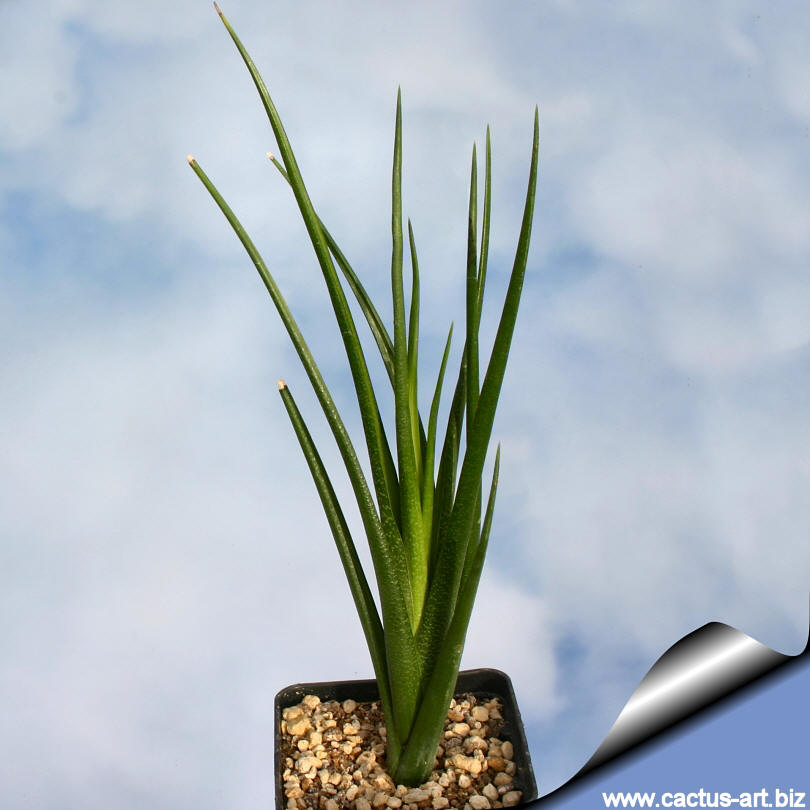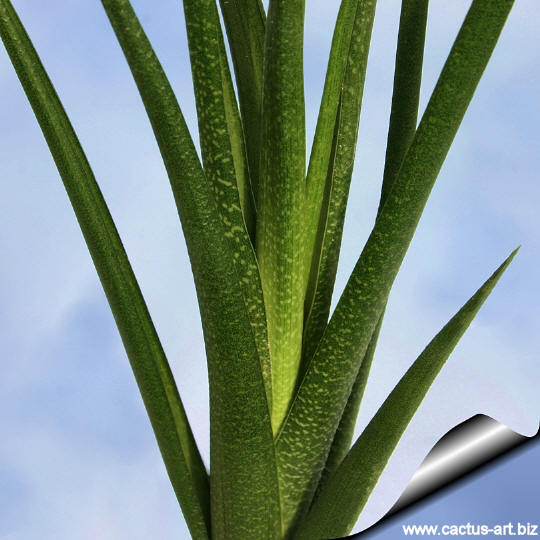|
|
|

Haworthia longiana Gamtoos River Valley (very long leaved form)
This is one of the most distinctive Haworthias and one of the
most unusual, because it has very long stiff green leaves and is not
seen very often in cultivation.
|
|
Description: Tall stemless
grass-like plant that looks like a miniature Agave, slowly forms clumps.
It can assume huge proportions by Haworthia standard,
but
the length and slimness of leaves
are quiet variable from plant to plant
depending on clone and origin. Some of its forms
can be almost unbelievably slow growing, producing no more than one or two
leaves a year, and remaining content in a 6 cm pot for decades.
Rosettes: Branching from the base, up to to 5-7 cm in diameter, up
to 30 cm tall; up to 30 leaves
Leaves: Bright green to very dark green often red-tipped in
bright light. Very upright in orientation, narrowly long, attenuated,
firm, rigid , stiff, slightly rough with small raised tubercles
(Sometime with white tubercles) and often forming indistinct
longitudinal rows. In cultivation like in habitat the leaf tips often
die back, this is normal and not a defect of cultivation.
Flowers: Cream white, born on a
sparcely branced, lax, inflorescences. Flower tube obcapitate and
curved, petal tips revolute.
|
|


Advertising
|
|
|
|
|
Family: Asphodelaceae
(Aloacee - Asphodelaceae, Liliaceae)
Scientific name: Haworthia
longiana von Poelnitz
In: Repert. Spec. Nov. Regni Veg. 41:203. 1937
Origin: Between Hankey and
Humansdorp in the Eastern Cape Province, Republic of South Africa,
Altitude 50 - 200 m
Habitat: Grows on stony hill
slopes well hidden
among sparse shrubs end grasses, but
often in full sun, plants are frequently grazed by herbivore animals.
Common English Names include:
Long leaved Haworthia
Synonyms:
- Haworthia longiana var.
albinota ( von Poelnitz) G.G.Smith.
- Haworthia pumila ssp.
longiana ( von Poelnitz) Halda 1997
|
|
|
|

To look its best it takes many years of tender loving care and
understanding making this long leaved Haworthia a great challenge to
grow well. Indeed this plant is very rare because it is such a slow
grower, or that it offsets only when mature, but most likely is that it
is a Haworthia that only a Haworthia aficionado could love.
Cultivation: In cultivation
it belongs to more slow-growing species, but
when successfully grown, it can be a very
nice. Due to its dead leaves tip
it's one of those plants which never
quite sure whether it's healthy or not,
newrthless it can form beautiful groups but to achieve this
target they need regular care and good positioning of plants as far as
full sun
and air circulation are concerned. Provide a
very draining soil (prone to rot). Needs
regular water in summer keep dry in winter.
Cold hardiness is good down to minus 7°
C.
Propagation: H.
longiana can be propagated from offsets (It
is a prolific grower and most of the clones offsets when mature).
|
|